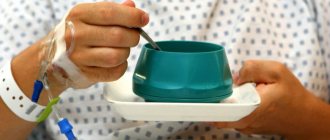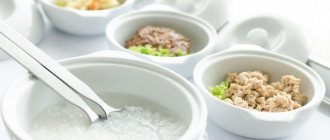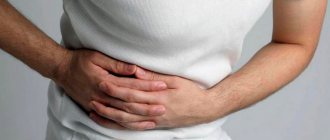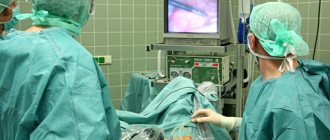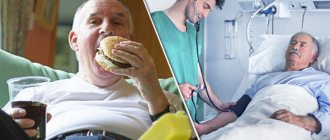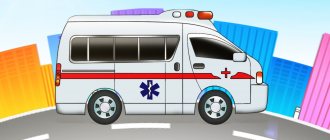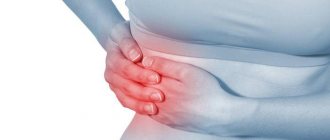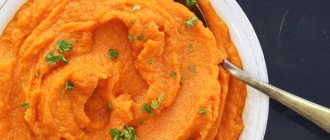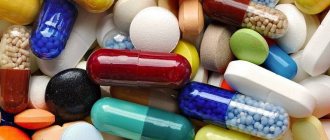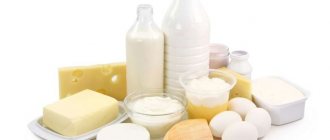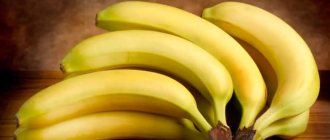When treating polyps in the large intestine, an important role is played not only by timely surgical intervention, but also by the rehabilitation period after colonoscopy. To prevent complications and speedy recovery, the patient is prescribed dietary nutrition.
It is designed to reduce the load on the digestive organs and prevent the processes of fermentation and flatulence in the freshly operated intestines. The diet after removal of polyps in the intestines by colonoscopy differs from other dietary tables.
Read about its features, permitted and prohibited food products in this article.
What is special about the diet?
The types of food allowed for consumption after removal of polyps are collectively called table No. 0. Yes, the menu is limited. The post-polypectomy diet allows the consumption of only certain foods prepared in a special way. But it's worth it.
As a method of removing tumors, colonoscopy is a more gentle and simpler operation than other methods. Despite this, some damage is still caused, and the mucous membrane needs to be restored.
After the mucous membrane has healed, it will be possible to switch to a normal diet, but during rehabilitation you should be very careful, because irritation can cause complications. A diet after removal of intestinal polyps by colonoscopy, on the contrary, will speed up recovery and allow you to switch to your usual diet much faster. The diet looks exactly the same after removal of a polyp in the rectum - you should follow all the recommendations listed.
Three parts diet
The regimen during rehabilitation after this operation is quite simple. It includes three periods.
After the procedure, a diet is prescribed after removal of polyps in the intestines, the first days of which will be the most restrictive. This period lasts three days. The first day you will have to do without food at all - you cannot eat any food or drink. The next day you are allowed to drink, and in the evening you can eat; broth or low-fat soup is allowed. On the morning of the third day you can have a decoction of rice and jelly. There is no other way - the complex healing process of the intestinal wall can be easily disrupted if bile or digestive juice gets into the intestine. Recovery will take much longer.
The second part lasts from the 4th to the 14th day. Liquid porridges and soups are allowed here. If the patient has increased gas formation, the nutritionist will develop alternative dishes. The goal of the second stage is to gradually increase the load on the intestines.
The third part of the diet lasts from the 14th day to the fourth month inclusive. Here you will also have to sit on semi-liquid porridges and soups. You can add solid food, provided it is low-fat. Foods high in fiber are absolutely excluded.
The main condition for all dishes that the diet allows after removal of polyps in the intestines is a high content of proteins and amino acids in the absence of coarse fiber and irritants. The best dishes for this are soups with meat broth, milk products and easily digestible cereals.
Dish recipes
The range of permitted products is characterized by diversity. Therefore, there will be no problems with creating a diet menu. The same ingredients can be cut into small cubes or strips, and different heat treatments can be used. The end result is completely different dishes.
Stew without meat
First you need to prepare all the vegetables: potatoes, zucchini, onions, corn, sweet peppers, carrots. All ingredients (except corn) are cleaned and crushed. Whether it's cubes or straws, it doesn't matter. Potatoes and carrots are simmered in vegetable oil in a pot for 2-3 minutes, after which the vegetables are poured with water. 10 minutes after boiling, add the remaining ingredients. The water should cover the contents of the pan. Simmer for another 10-15 minutes. At the end, the dish is salted and sprinkled with fresh herbs.
Stew with meat
It is better to prepare this dish in a slow cooker or oven. Vegetables cut into strips (potatoes, eggplants, carrots and bell peppers) are poured with boiling water and kept for 15 minutes under a closed lid. At this time, the poultry meat is cut into cubes and simmered in a frying pan in vegetable oil for about 10 minutes. Combine all ingredients in a baking dish or multicooker bowl. Salt the workpiece and pour in a sauce made from sour cream and water (take 2 tablespoons of sour cream per 200 ml of liquid). Simmer until done (30-45 minutes).
Pour water into a saucepan and place it on the fire. Before boiling, add diced vegetables:
After 15 minutes, place a gauze bag containing pieces of perch or carp into a boiling container. You can use assorted fish; dietary principles are not violated by such variety. After 20 minutes, add some salt to the fish soup and remove from the heat. The final touch is chopped greens. It is added to the pan or directly into the bowl.
Vegetable soup
Prepared without meat or with (low-fat) broth. Add diced vegetables to a saucepan with boiling liquid:
After the vegetables become soft, remove the pan from the heat and enrich the soup with fresh herbs (dill, parsley).
Tilapia fillet
Rinse the fish and dry with a napkin. Add a little salt and roll in breadcrumbs. Place the fillet on foil and pour a sauce of olive oil (a few drops) and lemon juice (1 tsp). Bake in foil, setting the oven temperature to 180°. After 15 minutes, open the foil, brush the top of the fish with sour cream and leave to bake for another 5 minutes. When serving, the dish is sprinkled with fresh herbs.
Steamed cutlets
Grind veal (300 g) in a meat grinder using a fine sieve. Add to minced meat:
- salt (1/2 tsp without a slide);
- sour cream (1 tbsp);
- egg (1 pc.);
- chopped greens (dill, cilantro, green onions).
Mix the resulting mass and form into cutlets. Place the pieces on the steamer stand. Leave covered for 25 minutes.
Oatmeal jelly
Oatmeal flakes (200 g) are poured with water (500-600 ml) and left in the container for 20-24 hours. If signs of fermentation are detected, you can continue preparing the drink. The fermented product is passed through a sieve. The flakes are thrown away, the liquid is slightly salted and sugar is added (1.5 tbsp). Cook over moderate heat with constant stirring until boiling. As soon as the bubbles appear, the jelly is removed and poured into cups.
What is acceptable and what is not allowed to eat?
Only diet will help restore the intestines; after removal of the polyp, the intestinal walls will take a long time to heal, and what you eat can affect the speed of recovery. The food should contain a large amount of vitamins and microelements, but at the same time it should not interfere with healing or irritate damaged intestinal walls. And the damage can be large, especially if there is more than one polyp.
Let's start with what not to eat. First, you should eliminate the most powerful irritants, such as fresh fatty milk, hot spices, coffee, and carbonated drinks. The prohibited list includes smoked products, semi-finished meat products, hard vegetables, such as cabbage, beans, baked goods, marinades, mushrooms, and canned food. Any solid foods such as grains or nuts are also excluded.
What is recommended to eat? The main dish - porridge - is quickly and easily digested, butter and vegetable oil, tea. Cottage cheese, low-fat kefir, sour cream and cheeses are allowed. You can also add lean meat, boiled or steamed, fish, rye bread and fruit.
It is important to remove seemingly harmless milk and millet from the menu, especially in the first few days. After the initial two weeks they can be returned.
Your doctor may recommend enzyme tablets to take before meals. They facilitate the digestion of food and accelerate the absorption of vitamins and nutrients into the blood.
Each organism is individual. The patient's condition depends on his immunity. In some cases, the doctor allows you to supplement your diet with other dishes that are sources of vitamins, proteins and antioxidants. Then the diet after removal of the intestinal polyp by endoscopic method allows you to include fats in adequate quantities. These should be healthy fats; red fish and dairy products are allowed. Approximately the same dishes and products are prescribed by a doctor for other gastrointestinal problems. The diet after removal of a polyp in the cecum looks exactly the same.
Basic principles of nutrition after endoscopic removal of intestinal polyps
- Frequent meals - 5-6 times a day. Classic three meals a day is not recommended. It overloads the digestive tract with large volumes of food and creates conditions for the feeling of hunger.
- Fractional meals. The volume of portions is reduced by half or a third from the usual.
- Diet. It is recommended to eat at approximately the same time and maintain the same interval between meals.
- No feeling of hunger. Fasting increases the production of digestive enzymes, which is undesirable in the initial stages of intestinal recovery.
- Cooking gentle food. Fried foods are prohibited. All products are steamed or boiled and crushed as much as possible. It is not recommended to eat too hot or cold foods.
- Drinking regime. For normal kidney and heart function, you need to drink at least 1.5 liters of fluid per day. Drinking enough water facilitates the digestion of food and normalizes intestinal motility.
- Physical activity. While on a diet, you need to lead a moderately active lifestyle: do therapeutic exercises and yoga. Walking will be beneficial. It is important to avoid overwork and not engage in heavy physical work.
Some tips
After surgery, follow several rules, regardless of how much time has passed since surgery:
- Establish a new diet to reduce the amount of work your intestines do. To do this you will have to eat at least five times a day. We do this to avoid feelings of hunger, which stimulates the secretion of gastric juice. Namely, gastric juice irritates the intestinal walls. The intervals between meals should not exceed more than three hours. Between lunch and afternoon snack, you can take a little olive oil, which facilitates digestion and has a beneficial effect on the gastrointestinal tract as a whole;
- consume as much protein as possible. Surgery is a big stress for the body. The immune system will work harder, and the body needs adequate nutrition. Therefore, it is necessary to take additional protein. If you do not have concomitant problems with the gallbladder and your age is less than 40, then it is acceptable to drink whole milk;
- You can also add boiled vegetables, because they are a source of vitamins and complex carbohydrates. But vegetables should only be consumed in the form of purees, which are easily digested. Any spicy or irritating vegetables, such as daikon and radishes, are excluded. Dairy products are consumed in moderation. To eliminate the risk of severe gas formation, give preference to dried bread or crackers;
- In the first days, when you are still taking medications or antibiotics, you should remember about the liver and kidneys. These days they will work hard, because they have to remove the remaining drugs from the blood. In this case, light dishes are useful, for example, vegetable broths and chicken broths, and beef broth is also useful. They contain a lot of amino acids, which are exactly what the body requires;
- You can take supplements of microelements and vitamins that are lacking in your diet. This is lutein, vitamins E and D, contained in the yolk of the egg, which can be used after the procedure, but in limited quantities. Eating eggs is allowed, but no more than a couple of eggs per day. Eggs are prepared only soft-boiled or scrambled. Vitamins do not have to be obtained only from supplements; you are allowed to drink berry or fruit juice, and berries and fruits are an excellent source of vitamins. No sour fruits. Doctors advise diluting juices with water and eating fruits without peels. An excellent alternative to juices is compote.
Conclusion: before adding a type of food to the menu, thoroughly check whether it could be an irritant that will interfere with the healing of the intestinal walls. Try to eat finely grated or mashed food; it should not contain coarse fibers or large pieces.
You should eat little, exactly as much as your body needs. The diet after polyp removal prescribes eating meals in small portions. Overeating will also irritate the intestines. Special meals are prescribed before the colonoscopy to cleanse the intestines.
An important part of the rehabilitation period after removal of polyps is the restoration of the intestinal microflora to a normal state. Good microbes are killed or weakened by medications and antibiotics. Therefore, probiotics are prescribed, natural yogurt, for example, which will help restore intestinal flora.
A month after the colonoscopy, you should see the doctor for a second examination. It will determine how much your body has recovered and whether polyps remain in the intestines. The diet continues for another three months. Even with good recovery, you should not smoke, drink alcohol, eat smoked or pickled foods, or add hot seasonings. Sweets, such as ice cream and chocolate, should also not be consumed.
If you also have liver problems, you will have to exclude heavy foods such as mushrooms, beans, garlic and some others. Here you should ask your doctor for recommendations.
Prevention of disease relapse
Prevention of the disease consists of reducing the level of irritants that cause symptoms of the disease. The causes of rectal polyps are not clear. To prevent the disease, an integrated approach is chosen, including a certain diet and an active lifestyle.
Separate nutrition for polyps is an important component. The recommendation helps to exclude products that have a negative effect on the gastrointestinal tract, due to which polyps appear. A proper approach to food will save your health and free you from surgery.
A lot depends on your lifestyle. A sedentary lifestyle leads to blood stagnation - the cause of the development of polyps. An active lifestyle and nutrition are designed to help get rid of unpleasant symptoms.
The disease is influenced by heredity - the factor cannot be corrected. The only way out of the situation is a vigilant attitude towards health. By neglecting themselves, people trigger illnesses, taking them to extremes. Timely consultation with a doctor and treatment will help get rid of severe consequences.
Surgery for polyps is the only way out. If it occurs, advice on nutrition and daily routine remain relevant. A constant regimen and proper diet do not lead to negative consequences.
Polyps are abnormal growths of benign tissue. They are formed on the mucous membrane in the form of a drop on a thick base or thin stalk. Such growths do not pose a danger in themselves, but under the influence of external factors, polyps can transform into a malignant tumor.
Approximate menu
To get a rough idea of what the diet looks like after intestinal polypectomy, we have provided an approximate menu:
- In the morning, eat a soft-boiled egg or steam beaten eggs. You can also drink a cup of herbal infusion or weak tea. Alternative: buckwheat or oatmeal with added butter, cooked in water. Porridge can also be used as a second breakfast if you add a piece of boiled meat to it. As a drink, a glass of low-fat kefir or tea.
- For lunch, broth soup with vegetables or buckwheat porridge with a steamed cutlet are suitable. Stewed cabbage is a good addition to the side dish.
- As an afternoon snack, a glass of milk or berry jelly. A wonderful snack – baked apples with honey.
- For dinner you can eat crackers with milk or mashed potatoes. As a dessert, natural yogurt with berries or cottage cheese. An alternative is chicken or beef broth soup, vegetable stew and banana for dessert.
Remember that a proper diet and a healthy lifestyle without bad habits will help prevent the development of polyps in the future, but will not allow you to remove existing ones. However, if you have polyps, a diet for intestinal polyps will prevent them from developing further and will prevent them from getting injured or bleeding. Therefore, healthy eating should become a constant for you.
IMPORTANT! Informational article! Before use, you should consult a specialist.
Special instructions
At the same time, you should pay attention to your own health. With the doctor's permission, you can start light exercises and short walks. Smoking and drinking alcoholic beverages is prohibited. Eliminate confectionery and flour products or significantly limit consumption to 2 times a week.
Heavy foods and complex foods burden the digestive process, stimulate fermentation and gas formation, which will certainly negatively affect the condition of the epigastric organs.
Sample menu
Nutrition after intestinal colonoscopy does not require refined foods, and therefore is quite affordable, and also healthy. So:
- Day 1 : steam omelette, glass of green tea; for lunch, noodle soup with chicken broth, boiled beet salad with sour cream; crackers for an afternoon snack, mashed potatoes for dinner with a steamed cutlet.
- Day 2 : semolina porridge, cheese, black tea with milk without sugar; soup from any cereal with sour cream, croutons, vinaigrette; jelly and a glass of jelly for an afternoon snack; breaded chicken chop and rice.
- Day 3 : in the morning boiled buckwheat porridge, a glass of tea; soup with meatballs, fresh cucumber salad with sour cream; for an afternoon snack, a bun with milk; for dinner, beef chop with boiled potatoes.
- Day 4 : morning - steam omelette with herbs; lunch - borscht without meat with sour cream, boiled beet salad with prunes; for an afternoon snack, cookies and a glass of cranberry juice; For dinner, steamed fish cutlet with cheese.
- Day 5 : rice porridge with honey; for lunch, noodle soup with chicken broth, vinaigrette, croutons; for an afternoon snack, drinking yogurt; dinner - macaroni and cheese.
